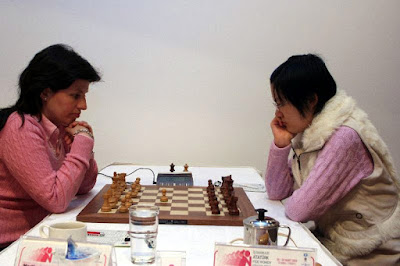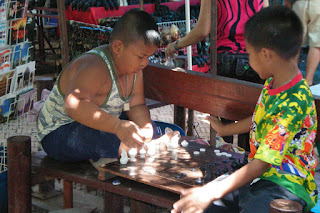Di tutte le obiezioni agli scacchi960 – idem to say Fischerandom – la più trita e sincera è stata esposta a Roma nel 2006 dal Grande Maestro Oleg Romanishin. A.D.R.:
Perché eliminare la teoria e consentire a chiunque di partire dallo stesso livello? Ho studiato gli scacchi per quarant’anni e mi fate partire allo stesso livello di qualcuno che ha trascorso tutto quel tempo a bere e guardare la TV?A domanda rispose, ancorché dalla segregazione cellulare di un carcere giapponese, l’undicesimo Campione del Mondo di scacchi classici Bobby Fischer:
Non mi piace riposare sugli allori. Oggi mi interessano i Fischerandom, progetto un nuovo orologio. Oggi mi preme di rendere gli scacchi un gioco più avvincente. Non mi interessa crogiolarmi sulla mia sedia a dondolo pensando a quel che feci dieci, venti o trent’anni fa.Nonostante le fisiologiche e prevedibili resistenze del circuito, oggi – seppellito Fischer – gli scacchi960, relegati in origine dagli organismi internazionali e nazionali nel “ghetto” dei ludibri eterodossi, sono ormai una consolidata nicchia d’ogni cartellone-carrozzone classico che si rispetti. L’interesse degli appassionati, insomma, ha costretto organizzatori e dirigenti spesso tetragoni a contemplare gli scacchi “eretici” di Fischer nel pantheon delle 64 case. Per il momento accontentiamoci!
V. Gurevich (2445) – M. Zaitsev (2489)
Waldbronn, 26 aprile 2009
rnnkbrqb/pppppppp/8/8/8/8/PPPPPPPP/RNNKBRQB
Posizione 475
Waldbronn, 26 aprile 2009
rnnkbrqb/pppppppp/8/8/8/8/PPPPPPPP/RNNKBRQB
Posizione 475
![[ V. Gurevich (2445) – M. Zaitsev (2489); Waldbronn, 26 aprile 2009; rnnkbrqb/pppppppp/8/8/8/8/PPPPPPPP/RNNKBRQB; Posizione 475 ]](http://4.bp.blogspot.com/_9K724qHu96M/Szs8IcGVysI/AAAAAAAAAjQ/S2bjltSPSa0/s320/gurevich_tseitlin.png) 1. d4 f5. Ogni rassomiglianza con l’Olandese “classica” è una pia illusione! 2. Cc3 g5 3. Cb3 Cc6 4.e3 Ah5+ 5. f3 Cd6 6. 0-0-0 0-0-0 7. Af2 g4 8. Ah4 Tde8 9. Df2 Dc4. Era anche interessante una strategia “classica”, quale per esempio 9. ... e5 10. d5 Ce7. 10. h3 e5. O forse 10. ... gxf3 (ovvero 10. ... gxh3) 11. gxf3 (ovvero 11. gxh3) 11. ... f4 12. e4 e5 13. d5 Cd4. 11. d5 Cb4 12. a3. Dopo 12. hxg4 (Δ 12. ... fxg4 13. e4) il Bianco deve forse temere le conseguenze di 12. ... e4!?. 12. ... Ca6 13. Rb1. La risposta più promettente a 13. fxg4 è probabilmente ancora 13. ... e4!?. 13. ... gxf3 14. gxf3? Era imperativa 14. Ca5 e, a meno che il Nero non intendesse avventurarsi in pirotecnici sacrifici di Donna con 14. ... Dxc3!?? e/o 14. ... De2!??, propiziare una pacifica ripetizione di posizione: 14. ... Dc5 15. Cb3 Db6 16. Ca4 Db5 17. Cc3 Db6 =. 14. ... e4. S’illumina d’immenso l’Ah8. 15. Cd4 f4! Naturale e dirompente: l’attacco del Nero spiega le ali! 16. Ag5 fxe3 17. Axe3 exf3 18. Ah6 Cf5! 19. Axf8 Axd4 20. Dh2 Axc3 21. Axf3 Db5 22. b3 Ag6. Anche l’Alfiere campochiaro si dirige contro l’arrocco. 23. a4 Db6 24. Td3 Ah8. È imminente la catastrofe sulla diagonale a1-h8. 25. Aa3 Df6 26. Ra2. Con sintomatica rassegnazione, ma anche dopo 26. c3 Ce3 il Bianco è con le spalle al muro. 26. ... Cb4+! 0 : 1. Gurevich preferisce un dignitoso abbandono all’onta del matto... urbi et orbi: 27. Axb4 Db2# oppure 27. Rb1 Da1#.
1. d4 f5. Ogni rassomiglianza con l’Olandese “classica” è una pia illusione! 2. Cc3 g5 3. Cb3 Cc6 4.e3 Ah5+ 5. f3 Cd6 6. 0-0-0 0-0-0 7. Af2 g4 8. Ah4 Tde8 9. Df2 Dc4. Era anche interessante una strategia “classica”, quale per esempio 9. ... e5 10. d5 Ce7. 10. h3 e5. O forse 10. ... gxf3 (ovvero 10. ... gxh3) 11. gxf3 (ovvero 11. gxh3) 11. ... f4 12. e4 e5 13. d5 Cd4. 11. d5 Cb4 12. a3. Dopo 12. hxg4 (Δ 12. ... fxg4 13. e4) il Bianco deve forse temere le conseguenze di 12. ... e4!?. 12. ... Ca6 13. Rb1. La risposta più promettente a 13. fxg4 è probabilmente ancora 13. ... e4!?. 13. ... gxf3 14. gxf3? Era imperativa 14. Ca5 e, a meno che il Nero non intendesse avventurarsi in pirotecnici sacrifici di Donna con 14. ... Dxc3!?? e/o 14. ... De2!??, propiziare una pacifica ripetizione di posizione: 14. ... Dc5 15. Cb3 Db6 16. Ca4 Db5 17. Cc3 Db6 =. 14. ... e4. S’illumina d’immenso l’Ah8. 15. Cd4 f4! Naturale e dirompente: l’attacco del Nero spiega le ali! 16. Ag5 fxe3 17. Axe3 exf3 18. Ah6 Cf5! 19. Axf8 Axd4 20. Dh2 Axc3 21. Axf3 Db5 22. b3 Ag6. Anche l’Alfiere campochiaro si dirige contro l’arrocco. 23. a4 Db6 24. Td3 Ah8. È imminente la catastrofe sulla diagonale a1-h8. 25. Aa3 Df6 26. Ra2. Con sintomatica rassegnazione, ma anche dopo 26. c3 Ce3 il Bianco è con le spalle al muro. 26. ... Cb4+! 0 : 1. Gurevich preferisce un dignitoso abbandono all’onta del matto... urbi et orbi: 27. Axb4 Db2# oppure 27. Rb1 Da1#.









![[ A. Gabrielian - H. Nakamura, 28.06.2009 :: nnrqkrbb/pppppppp/8/8/8/8/PPPPPPPP/NNRQKRBB ]](https://2.bp.blogspot.com/_9K724qHu96M/SwLCehPr-nI/AAAAAAAAAiY/RNhcDb2_m2s/s320/dinamite_nakamura.png)













![[ Lauberte - Benini (Stoccolma, 1937) :: Posizione dopo 54. h6 ]](https://2.bp.blogspot.com/_9K724qHu96M/Su_8zmlClbI/AAAAAAAAAho/MlJ2Nn7N8e8/s320/lauberte_benini.png)







![[ H. Nakamura – L. Aronian / 1ª del match; Magonza, 30 luglio 2009 / FEN 'nrnkrbbq/pppppppp/8/8/8/8/PPPPPPPP/NRNKRBBQ' / Posizione 190 ]](http://4.bp.blogspot.com/_9K724qHu96M/Sp7CB9iw0FI/AAAAAAAAAhA/bD6g99uBTQw/s320/nakamura_aronian.png)




![[ Mind Games Forever ]](https://3.bp.blogspot.com/_9K724qHu96M/SlS1B81BqHI/AAAAAAAAAgI/g7VmqI0R5YY/s400/dali_marti%26C.jpg)
![[ Scacchi & Danza ]](https://2.bp.blogspot.com/_9K724qHu96M/SlRzUjU1yEI/AAAAAAAAAgA/xGdr-_4O5-A/s400/molindelpiano+005+copia.jpg)
![[ Bobby Fischer a Pasadena nel 1974 ]](https://2.bp.blogspot.com/_9K724qHu96M/SkUX-KD29aI/AAAAAAAAAf4/y5XpX1fIx1E/s16000/Fischer_Pasadena_1974.jpg)


![[ Wyvill vs. Dubois (Roma, dicembre 1845) / r1bqk3/ppp3br/2n2nQ1/3pP2p/2BP2 ]](http://1.bp.blogspot.com/_9K724qHu96M/Sgw3XjzAfUI/AAAAAAAAAfg/CA_ZKDGdgmM/s320/Wyvill_Dubois_Roma_dicembre1845.png)



![[ SCACCHI960/FISCHERANDOM CHESS ]](http://1.bp.blogspot.com/_9K724qHu96M/SgLx7yZlmcI/AAAAAAAAAfA/DqHkEDDpfK4/s320/nrbbqkrn.png)